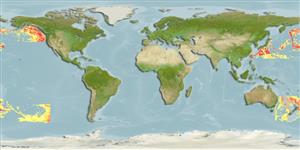Colossendeis japonica Hoek, 1898
| Native range | All suitable habitat | Point map | Year 2050 |

|
| This map was computer-generated and has not yet been reviewed. |
| Colossendeis japonica AquaMaps Data sources: GBIF OBIS |
Envoyez vos Photos
Images Google |
No photo available for this species.No drawings available for Colossendeidae.
Images Google |
No photo available for this species.
Classification / Names Common names | Synonyms | CoL | ITIS | WoRMS
Pycnogonida | Pantopoda | Colossendeidae
Environment: milieu / climate zone / depth range / distribution range Écologie
; profondeur 703 - 4390 m (Ref. 2157). Subtropical
Distribution Pays | Zones FAO | Écosystèmes | Occurrences | Introductions
Northern Pacific: Japan, Kermadec Island and USA.
Length at first maturity / Taille / Poids / Âge
Maturity: Lm ? range ? - ? cm
Description synthétique Morphologie
Consistently small with long, ctraight, inflated proboscis. Distal 3 palp segments very short in relation to next proximal 2. Tarsus almost twice propodal length, claw of moderate length. Terminal oviger claw very long (Ref. 2157, p. 13).
Life cycle and mating behavior Maturité | Reproduction | Frai | Œufs | Fécondité | Larves
Members of the class Pycnogonida are gonochoric and sexually dimorphic. During copulation, male usually suspends itself beneath the female. Fertilization occurs as the eggs leave the female's ovigers. Males brood the egg masses until they hatch. Life cycle: Eggs hatch into protonymphon larva then to adults.
Référence principale
Références | Coordinateur | Collaborateurs
Child, C.A. 1994. (Ref. 2157)
Statut dans la liste rouge de l'IUCN (Ref. 130435: Version 2024-1)
statut CITES (Ref. 108899)
Not Evaluated
CMS (Ref. 116361)
Not Evaluated
Menace pour l'homme
Utilisations par l'homme
| FishSource |
Outils
Plus d'informations
Trophic Ecology
Éléments du régime alimentaire
Régime alimentaire
Consommation alimentaire
Ration
Prédateurs
Régime alimentaire
Consommation alimentaire
Ration
Prédateurs
Ecology
Population dynamics
Croissance
Taille/Âge
Longueur-poids
Longueur-longueur
Fréquences de longueurs
Mass conversion
Recrutement
Abondance
Taille/Âge
Longueur-poids
Longueur-longueur
Fréquences de longueurs
Mass conversion
Recrutement
Abondance
Life cycle
Reproduction
Maturité
Fécondité
Frai
Œufs
Développement de l'œuf
Larves
Dynamique des populations larvaires
Maturité
Fécondité
Frai
Œufs
Développement de l'œuf
Larves
Dynamique des populations larvaires
Distribution
Human Related
Profil d'aquaculture
Stamps, Coins Misc.
Stamps, Coins Misc.
Outreach
Taxonomy
References
Sources Internet
BHL | BOLD Systems | CISTI | DiscoverLife | FAO(Publication : search) | Fishipedia | GenBank (genome, nucleotide) | GloBI | Gomexsi | Google Books | Google Scholar | Google | PubMed | Arbre de Vie | Wikipedia (Go, chercher) | Zoological Record
Estimates based on models
Preferred temperature
(Ref. 115969): 2 - 3.9, mean 2.6 (based on 587 cells).
Catégorie de prix
(Ref. 80766):
Unknown.


